Abstract
1. This study assessed human diaphragmatic endurance under two conditions: during maximal inspiratory efforts (with minimal elevation of abdominal pressure) and during maximal expulsive efforts (with minimal elevation of pleural pressure). Performance was compared with that of the flexors of the elbow. 2. In series of eighteen sustained maximal efforts begun near functional residual capacity the decline in trans-diaphragmatic pressure was significantly greater during the expulsive than the inspiratory efforts (P less than 0.01). Diaphragmatic endurance was greater than that of the flexors of the elbow. 3. Electromyograms recorded during maximal and submaximal expulsive contractions indicated that the relatively rapid decline in abdominal pressure during the series of expulsive contractions reflected fatigue of the diaphragm rather than the abdominal muscles. Supramaximal phrenic nerve stimulation was used to check that complete activation of the phrenic motoneurone pool could be achieved during series of maximal expulsive efforts. 4. It is concluded that the reduced endurance capacity of the diaphragm during expulsive efforts did not reflect peripheral failure of the abdominal muscles or an inability to activate the diaphragm fully during those maximal efforts. 5. The deterioration in diaphragmatic performance when abdominal pressure is elevated may be due to an impairment of muscle perfusion.
Full text
PDF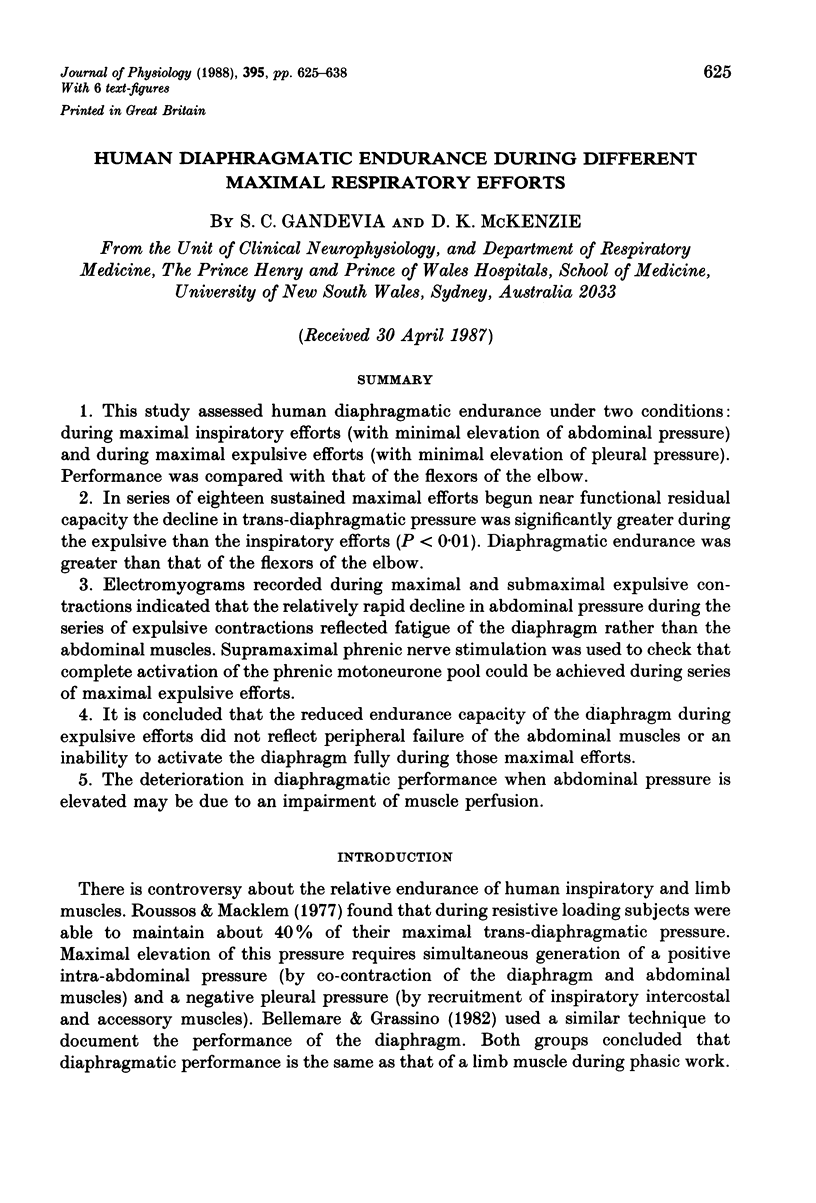
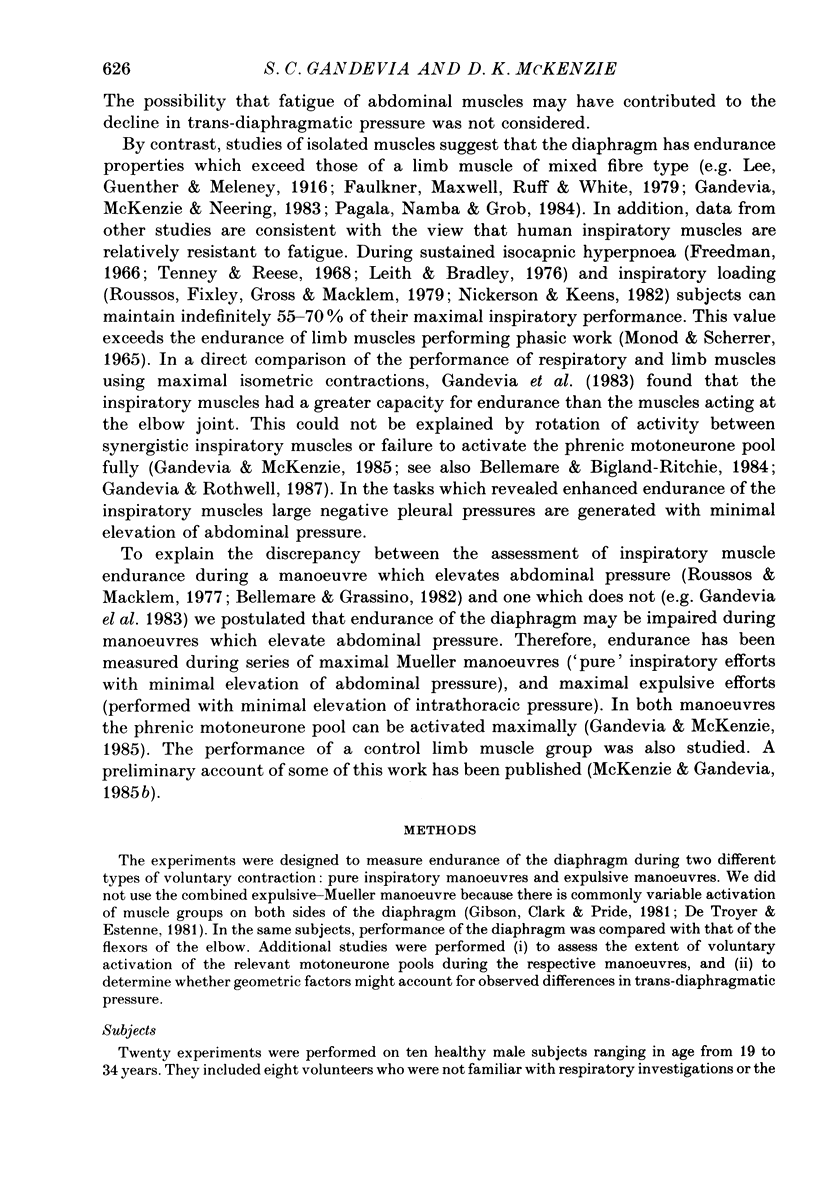
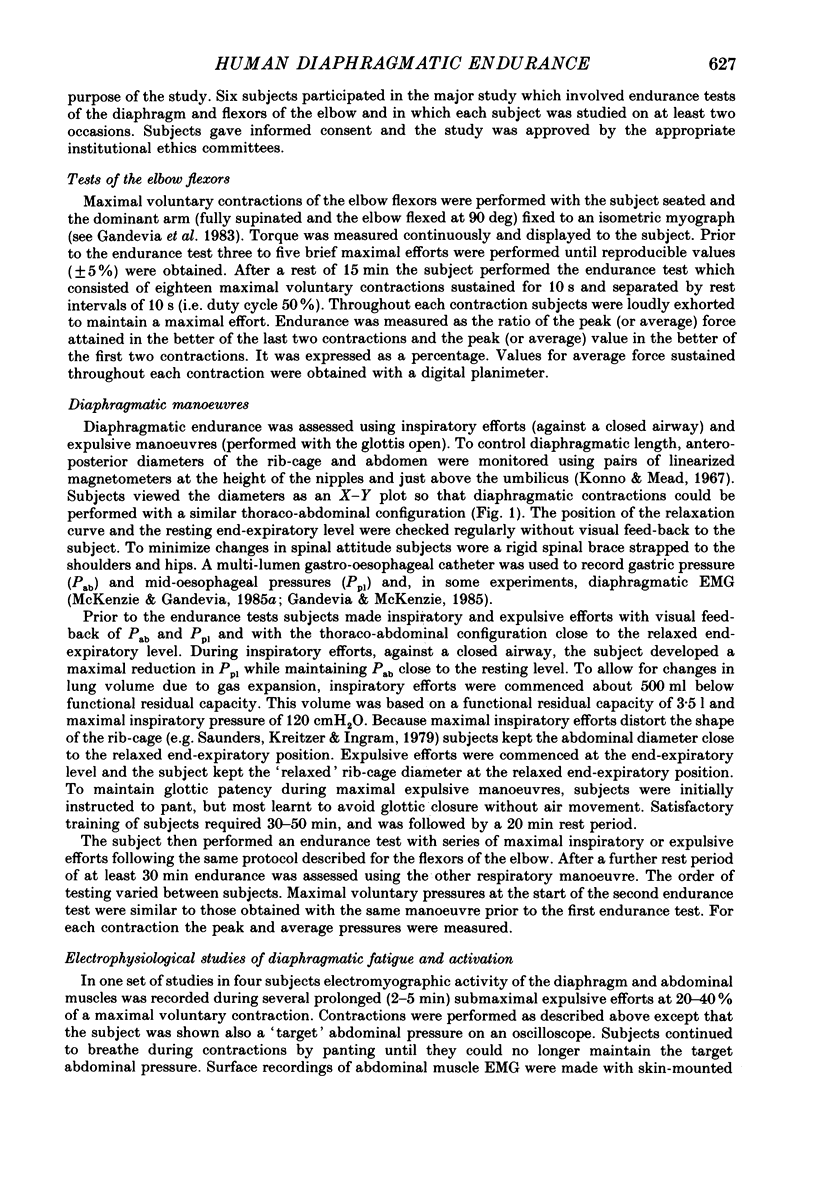
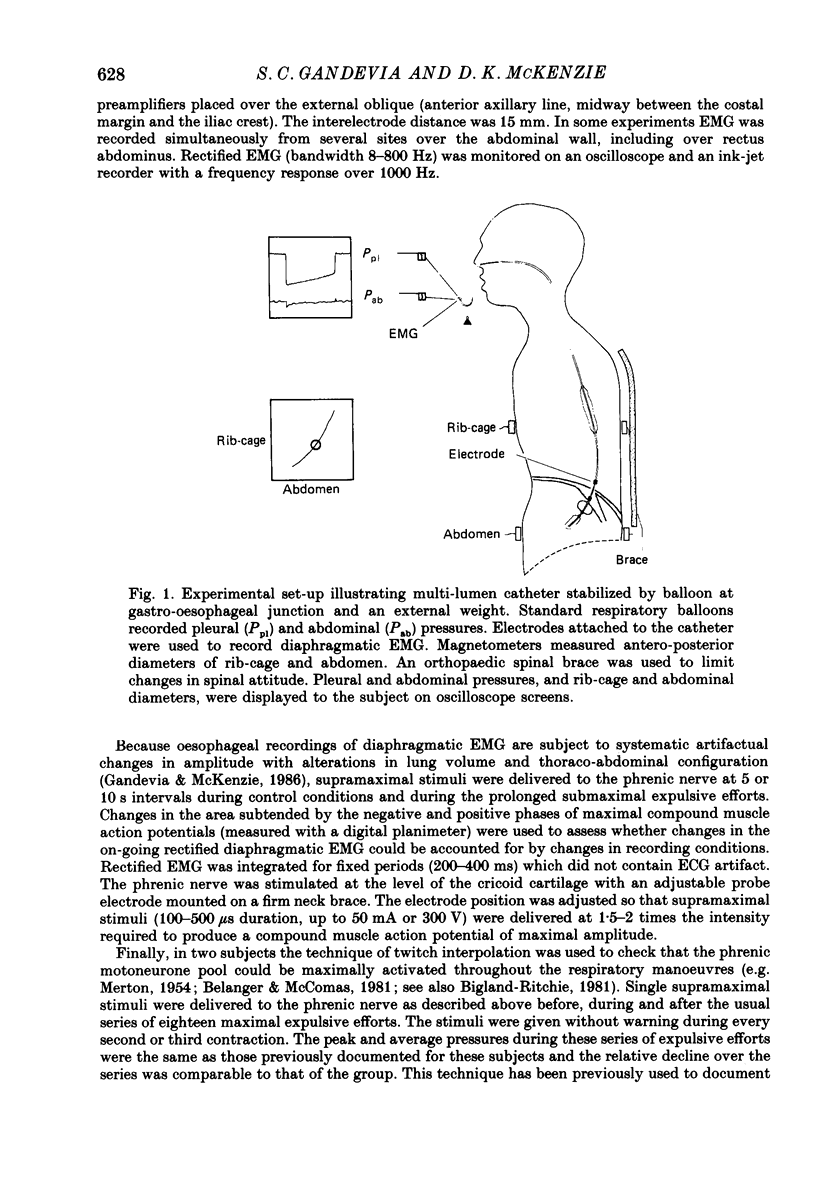
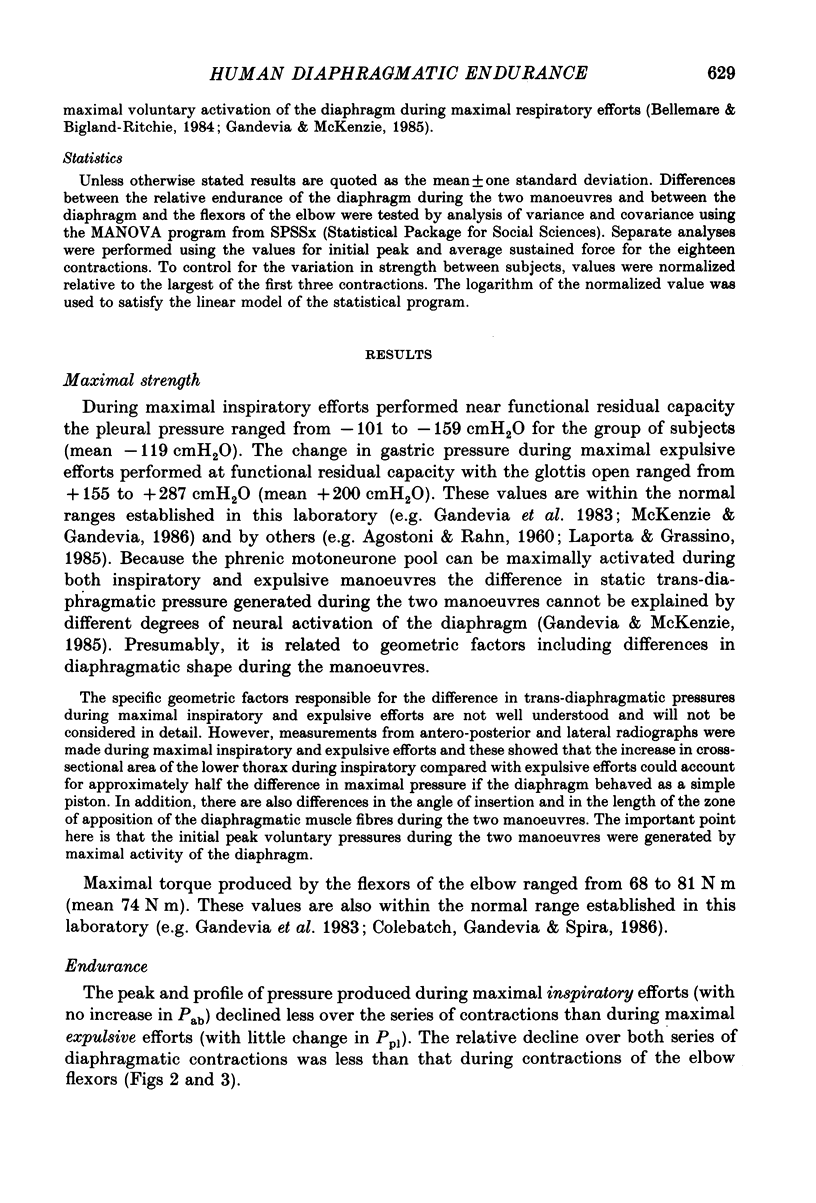
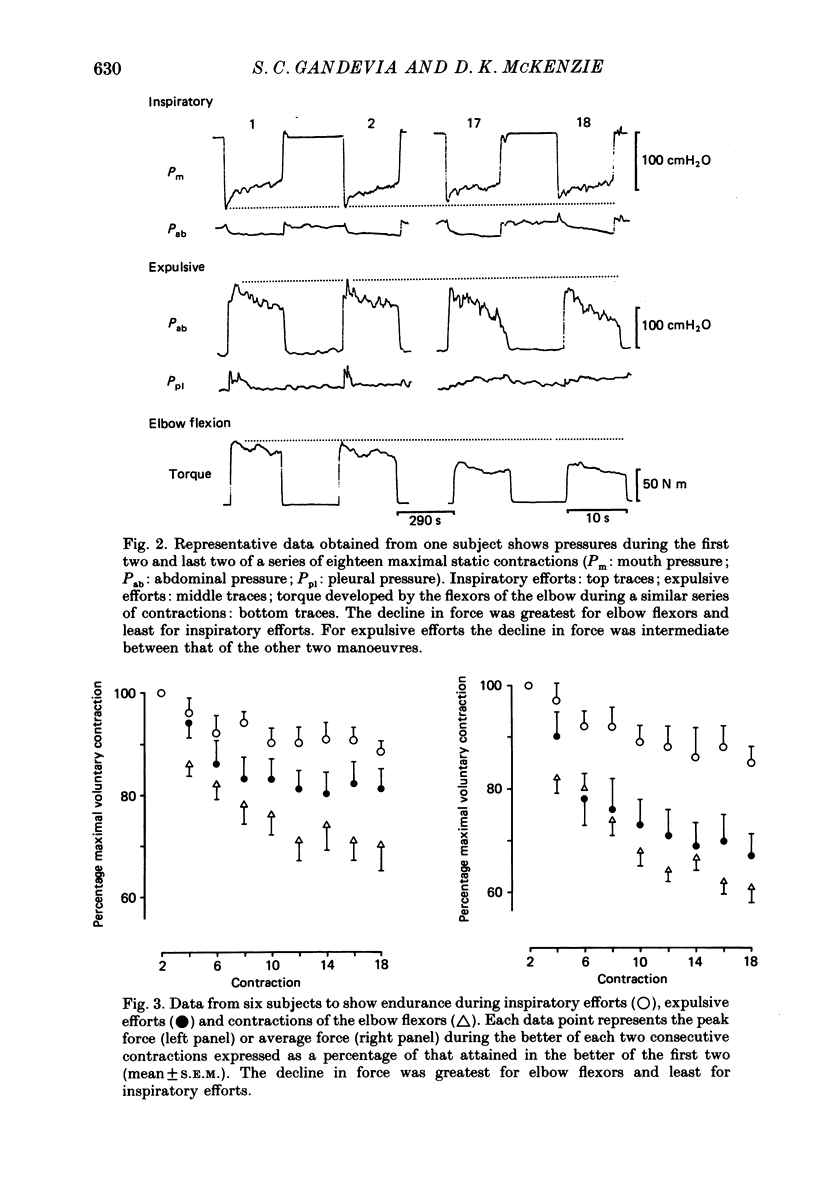
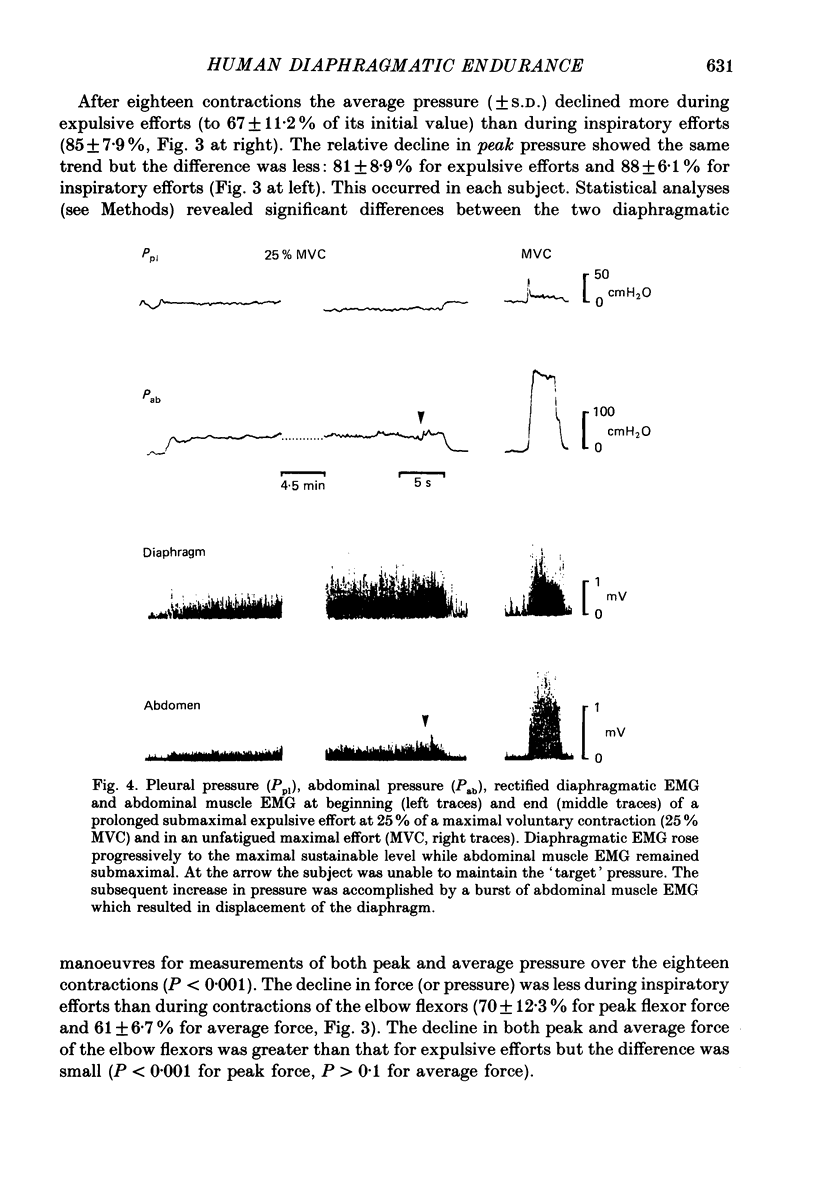
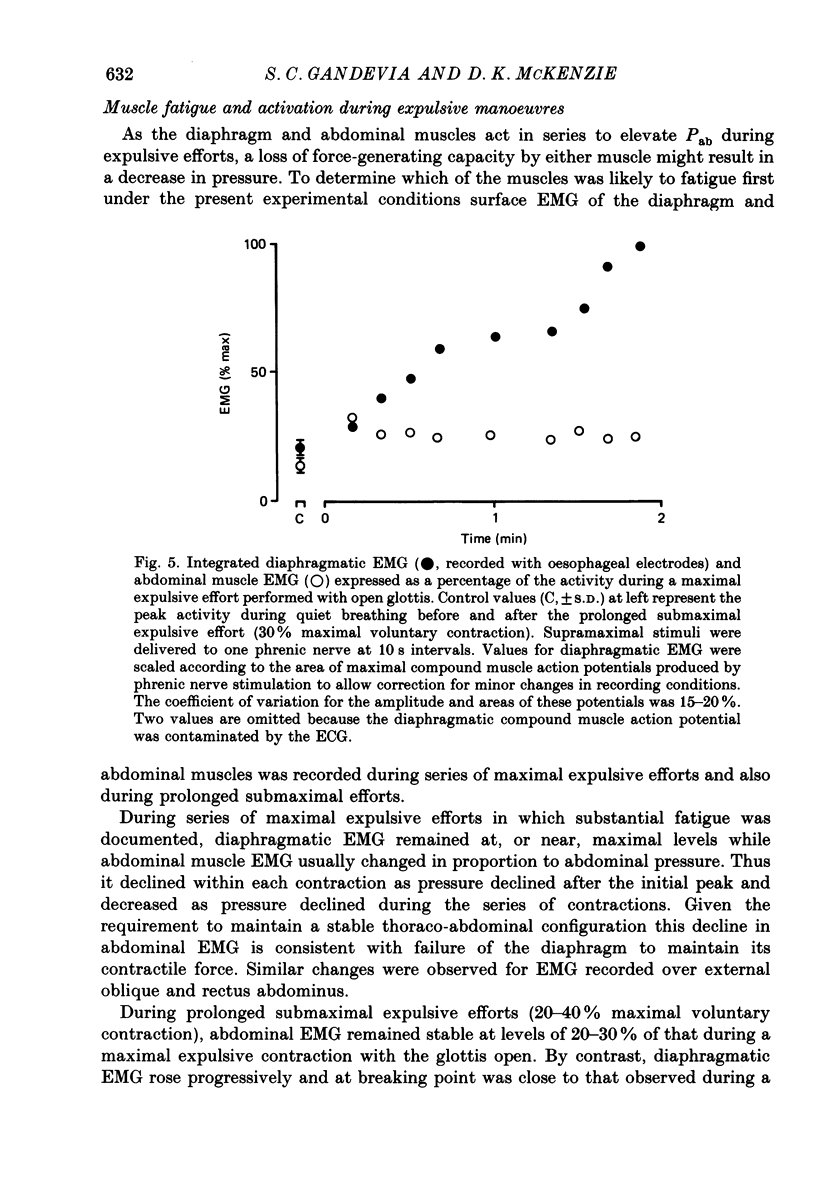
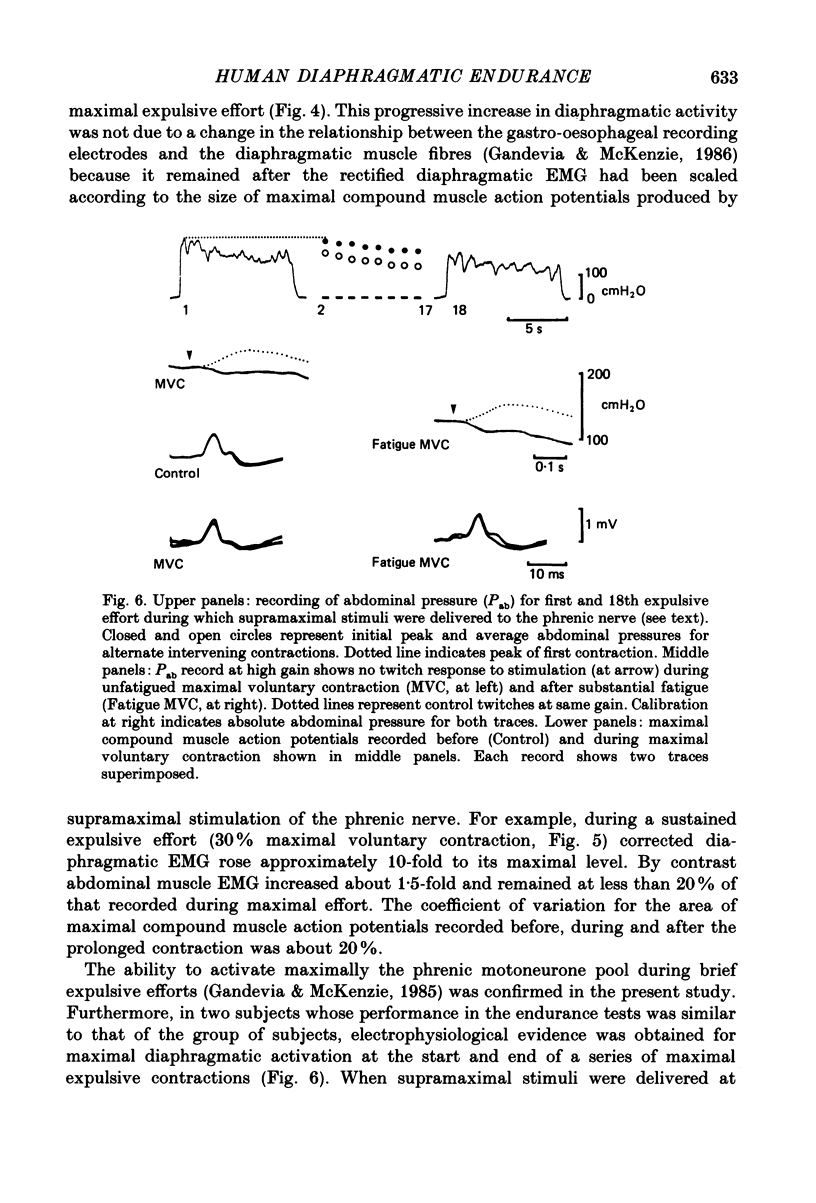
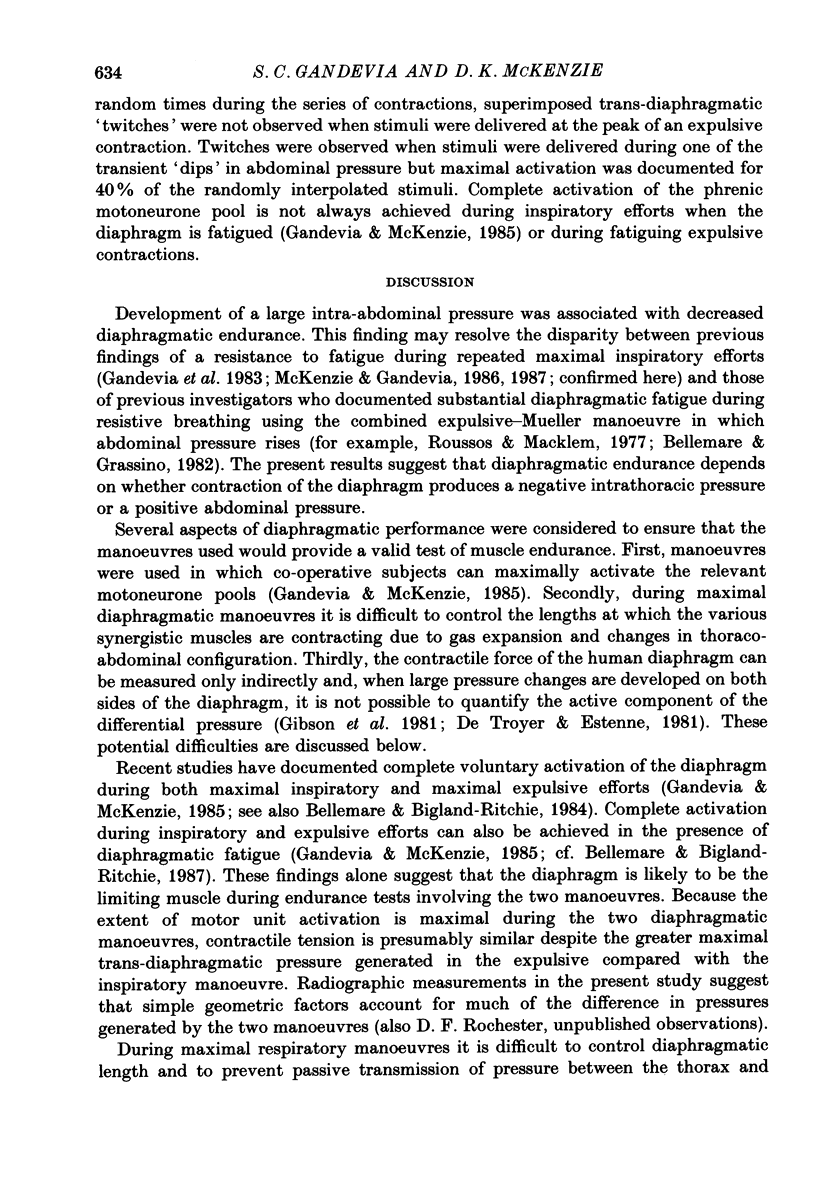
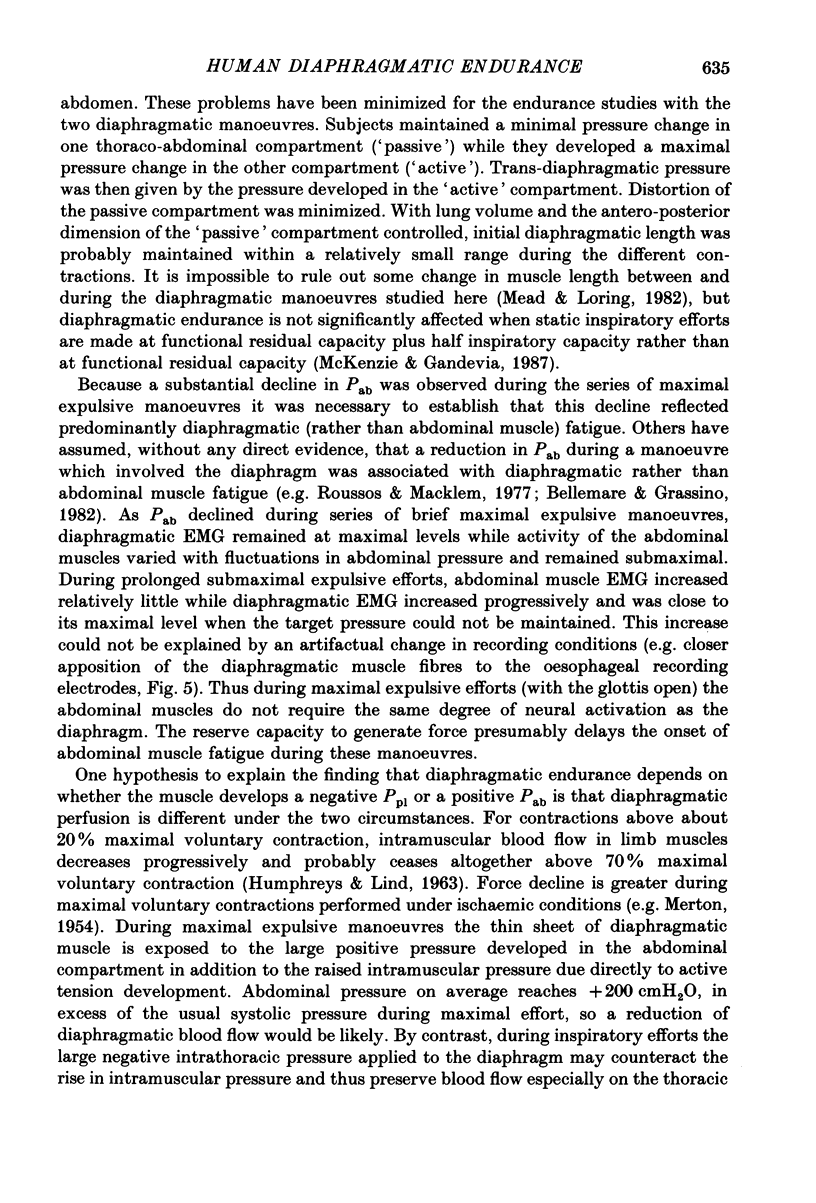
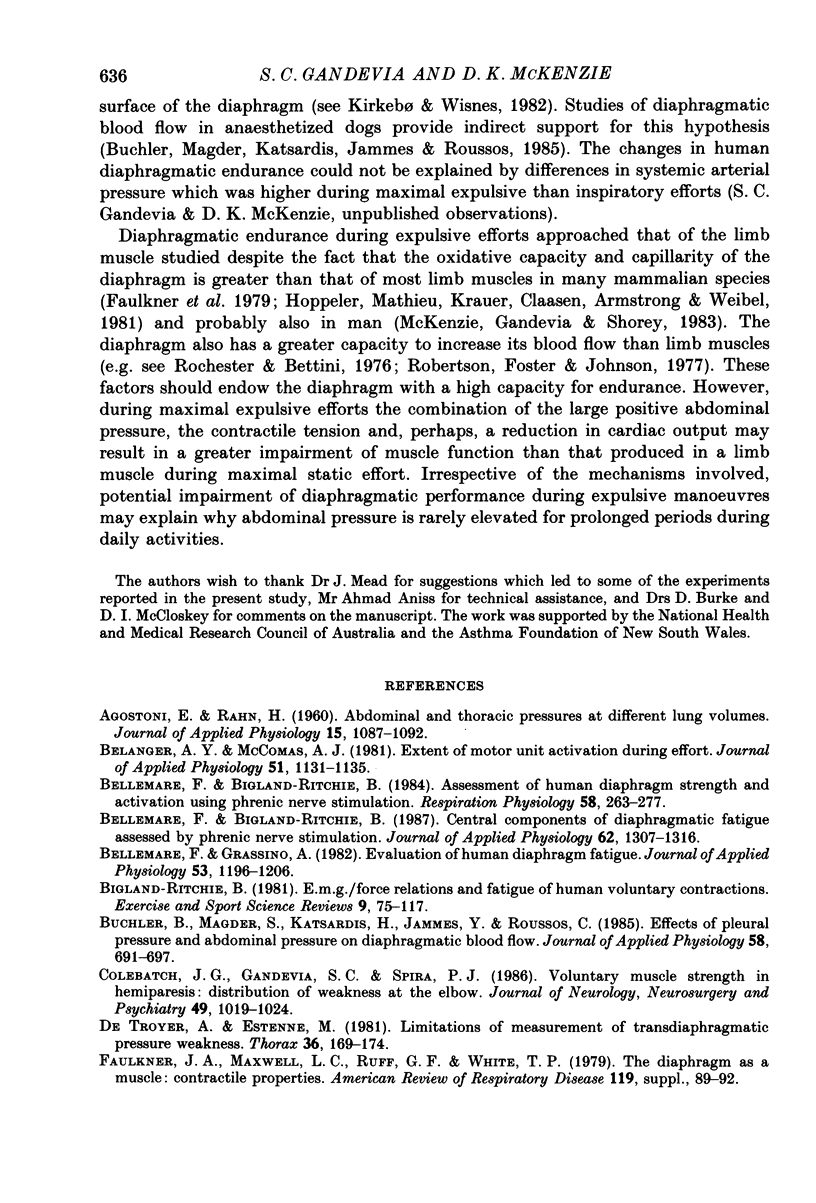
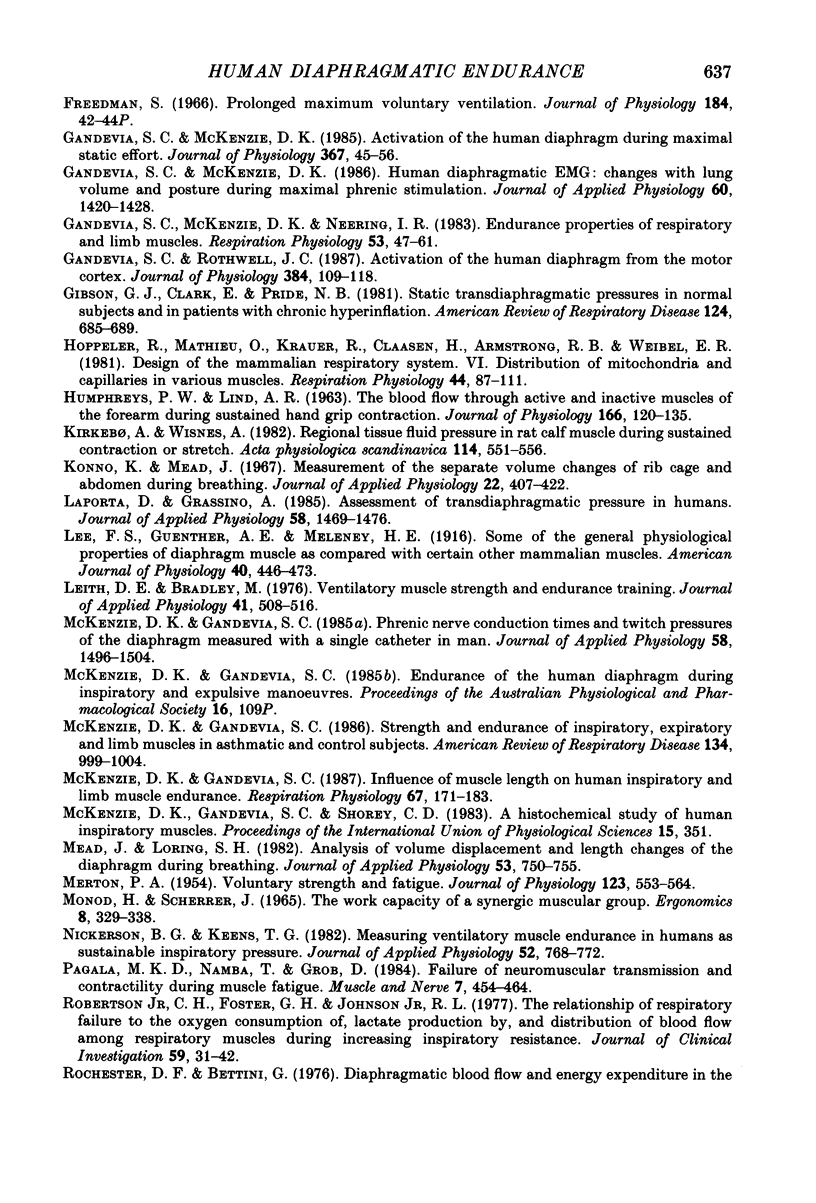
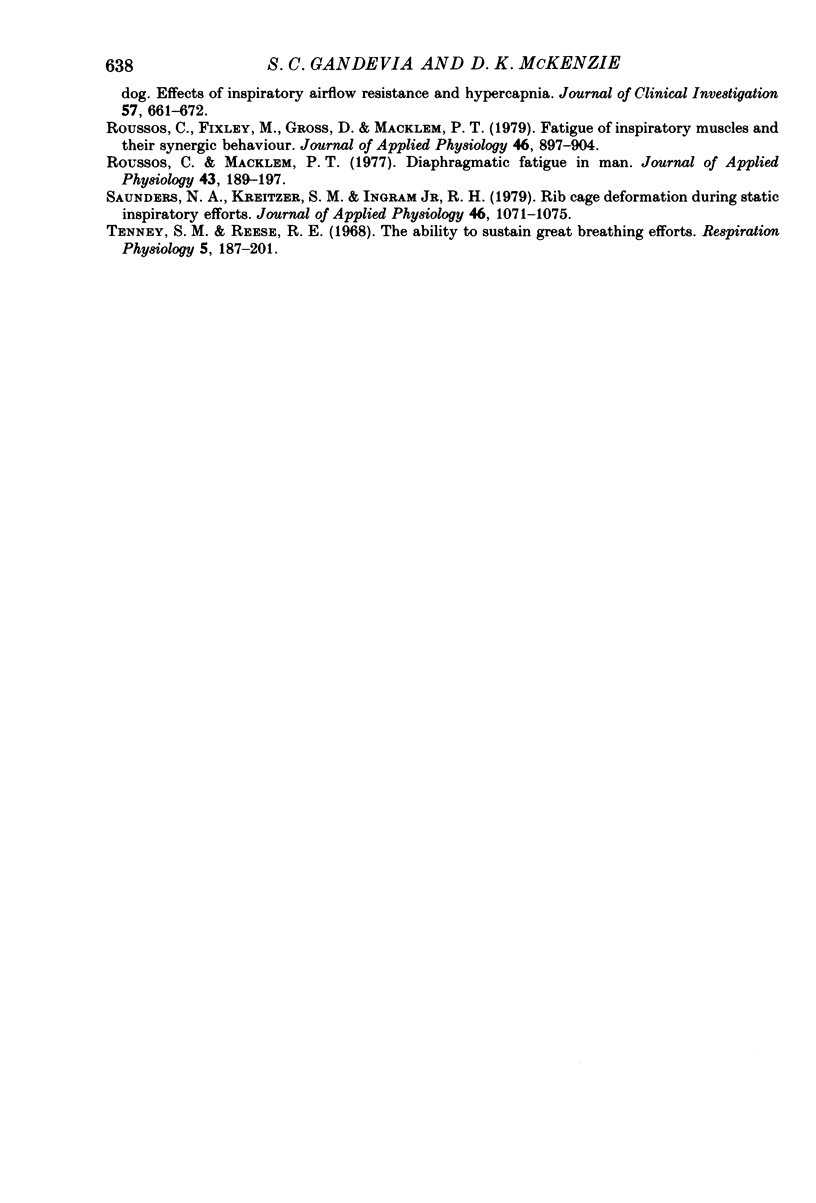
Images in this article
Selected References
These references are in PubMed. This may not be the complete list of references from this article.
- AGOSTONI E., RAHN H. Abdominal and thoracic pressures at different lung volumes. J Appl Physiol. 1960 Nov;15:1087–1092. doi: 10.1152/jappl.1960.15.6.1087. [DOI] [PubMed] [Google Scholar]
- Belanger A. Y., McComas A. J. Extent of motor unit activation during effort. J Appl Physiol Respir Environ Exerc Physiol. 1981 Nov;51(5):1131–1135. doi: 10.1152/jappl.1981.51.5.1131. [DOI] [PubMed] [Google Scholar]
- Bellemare F., Bigland-Ritchie B. Assessment of human diaphragm strength and activation using phrenic nerve stimulation. Respir Physiol. 1984 Dec;58(3):263–277. doi: 10.1016/0034-5687(84)90003-3. [DOI] [PubMed] [Google Scholar]
- Bellemare F., Bigland-Ritchie B. Central components of diaphragmatic fatigue assessed by phrenic nerve stimulation. J Appl Physiol (1985) 1987 Mar;62(3):1307–1316. doi: 10.1152/jappl.1987.62.3.1307. [DOI] [PubMed] [Google Scholar]
- Bellemare F., Grassino A. Evaluation of human diaphragm fatigue. J Appl Physiol Respir Environ Exerc Physiol. 1982 Nov;53(5):1196–1206. doi: 10.1152/jappl.1982.53.5.1196. [DOI] [PubMed] [Google Scholar]
- Bigland-Ritchie B. EMG/force relations and fatigue of human voluntary contractions. Exerc Sport Sci Rev. 1981;9:75–117. [PubMed] [Google Scholar]
- Buchler B., Magder S., Katsardis H., Jammes Y., Roussos C. Effects of pleural pressure and abdominal pressure on diaphragmatic blood flow. J Appl Physiol (1985) 1985 Mar;58(3):691–697. doi: 10.1152/jappl.1985.58.3.691. [DOI] [PubMed] [Google Scholar]
- Colebatch J. G., Gandevia S. C., Spira P. J. Voluntary muscle strength in hemiparesis: distribution of weakness at the elbow. J Neurol Neurosurg Psychiatry. 1986 Sep;49(9):1019–1024. doi: 10.1136/jnnp.49.9.1019. [DOI] [PMC free article] [PubMed] [Google Scholar]
- De Troyer A., Estenne M. Limitations of measurement of transdiaphragmatic pressure in detecting diaphragmatic weakness. Thorax. 1981 Mar;36(3):169–174. doi: 10.1136/thx.36.3.169. [DOI] [PMC free article] [PubMed] [Google Scholar]
- Faulkner J. A., Maxwell L. C., Ruff G. L., White T. P. The diaphragm as a muscle. Contractile properties. Am Rev Respir Dis. 1979 Feb;119(2 Pt 2):89–92. doi: 10.1164/arrd.1979.119.2P2.89. [DOI] [PubMed] [Google Scholar]
- Gandevia S. C., McKenzie D. K. Activation of the human diaphragm during maximal static efforts. J Physiol. 1985 Oct;367:45–56. doi: 10.1113/jphysiol.1985.sp015813. [DOI] [PMC free article] [PubMed] [Google Scholar]
- Gandevia S. C., McKenzie D. K. Human diaphragmatic EMG: changes with lung volume and posture during supramaximal phrenic stimulation. J Appl Physiol (1985) 1986 Apr;60(4):1420–1428. doi: 10.1152/jappl.1986.60.4.1420. [DOI] [PubMed] [Google Scholar]
- Gandevia S. C., McKenzie D. K., Neering I. R. Endurance properties of respiratory and limb muscles. Respir Physiol. 1983 Jul;53(1):47–61. doi: 10.1016/0034-5687(83)90015-4. [DOI] [PubMed] [Google Scholar]
- Gandevia S. C., Rothwell J. C. Activation of the human diaphragm from the motor cortex. J Physiol. 1987 Mar;384:109–118. doi: 10.1113/jphysiol.1987.sp016445. [DOI] [PMC free article] [PubMed] [Google Scholar]
- Gibson G. J., Clark E., Pride N. B. Static transdiaphragmatic pressures in normal subjects and in patients with chronic hyperinflation. Am Rev Respir Dis. 1981 Dec;124(6):685–689. doi: 10.1164/arrd.1981.124.6.685. [DOI] [PubMed] [Google Scholar]
- HUMPHREYS P. W., LIND A. R. The blood flow through active and inactive muscles of the forearm during sustained hand-grip contractions. J Physiol. 1963 Apr;166:120–135. doi: 10.1113/jphysiol.1963.sp007094. [DOI] [PMC free article] [PubMed] [Google Scholar]
- Hoppeler H., Mathieu O., Krauer R., Claassen H., Armstrong R. B., Weibel E. R. Design of the mammalian respiratory system. VI Distribution of mitochondria and capillaries in various muscles. Respir Physiol. 1981 Apr;44(1):87–111. doi: 10.1016/0034-5687(81)90078-5. [DOI] [PubMed] [Google Scholar]
- Kirkebø A., Wisnes A. Regional tissue fluid pressure in rat calf muscle during sustained contraction or stretch. Acta Physiol Scand. 1982 Apr;114(4):551–556. doi: 10.1111/j.1748-1716.1982.tb07023.x. [DOI] [PubMed] [Google Scholar]
- Konno K., Mead J. Measurement of the separate volume changes of rib cage and abdomen during breathing. J Appl Physiol. 1967 Mar;22(3):407–422. doi: 10.1152/jappl.1967.22.3.407. [DOI] [PubMed] [Google Scholar]
- Laporta D., Grassino A. Assessment of transdiaphragmatic pressure in humans. J Appl Physiol (1985) 1985 May;58(5):1469–1476. doi: 10.1152/jappl.1985.58.5.1469. [DOI] [PubMed] [Google Scholar]
- Leith D. E., Bradley M. Ventilatory muscle strength and endurance training. J Appl Physiol. 1976 Oct;41(4):508–516. doi: 10.1152/jappl.1976.41.4.508. [DOI] [PubMed] [Google Scholar]
- MERTON P. A. Voluntary strength and fatigue. J Physiol. 1954 Mar 29;123(3):553–564. doi: 10.1113/jphysiol.1954.sp005070. [DOI] [PMC free article] [PubMed] [Google Scholar]
- McKenzie D. K., Gandevia S. C. Influence of muscle length on human inspiratory and limb muscle endurance. Respir Physiol. 1987 Feb;67(2):171–182. doi: 10.1016/0034-5687(87)90039-9. [DOI] [PubMed] [Google Scholar]
- McKenzie D. K., Gandevia S. C. Phrenic nerve conduction times and twitch pressures of the human diaphragm. J Appl Physiol (1985) 1985 May;58(5):1496–1504. doi: 10.1152/jappl.1985.58.5.1496. [DOI] [PubMed] [Google Scholar]
- McKenzie D. K., Gandevia S. C. Strength and endurance of inspiratory, expiratory, and limb muscles in asthma. Am Rev Respir Dis. 1986 Nov;134(5):999–1004. doi: 10.1164/arrd.1986.134.5.999. [DOI] [PubMed] [Google Scholar]
- Mead J., Loring S. H. Analysis of volume displacement and length changes of the diaphragm during breathing. J Appl Physiol Respir Environ Exerc Physiol. 1982 Sep;53(3):750–755. doi: 10.1152/jappl.1982.53.3.750. [DOI] [PubMed] [Google Scholar]
- Nickerson B. G., Keens T. G. Measuring ventilatory muscle endurance in humans as sustainable inspiratory pressure. J Appl Physiol Respir Environ Exerc Physiol. 1982 Mar;52(3):768–772. doi: 10.1152/jappl.1982.52.3.768. [DOI] [PubMed] [Google Scholar]
- Pagala M. K., Namba T., Grob D. Failure of neuromuscular transmission and contractility during muscle fatigue. Muscle Nerve. 1984 Jul-Aug;7(6):454–464. doi: 10.1002/mus.880070607. [DOI] [PubMed] [Google Scholar]
- Robertson C. H., Jr, Foster G. H., Johnson R. L., Jr The relationship of respiratory failure to the oxygen consumption of, lactate production by, and distribution of blood flow among respiratory muscles during increasing inspiratory resistance. J Clin Invest. 1977 Jan;59(1):31–42. doi: 10.1172/JCI108619. [DOI] [PMC free article] [PubMed] [Google Scholar]
- Rochester D. F., Bettini G. Diaphragmatic blood flow and energy expenditure in the dog. Effects of inspiratory airflow resistance and hypercapnia. J Clin Invest. 1976 Mar;57(3):661–672. doi: 10.1172/JCI108322. [DOI] [PMC free article] [PubMed] [Google Scholar]
- Roussos C. S., Macklem P. T. Diaphragmatic fatigue in man. J Appl Physiol Respir Environ Exerc Physiol. 1977 Aug;43(2):189–197. doi: 10.1152/jappl.1977.43.2.189. [DOI] [PubMed] [Google Scholar]
- Roussos C., Fixley M., Gross D., Macklem P. T. Fatigue of inspiratory muscles and their synergic behavior. J Appl Physiol Respir Environ Exerc Physiol. 1979 May;46(5):897–904. doi: 10.1152/jappl.1979.46.5.897. [DOI] [PubMed] [Google Scholar]
- Saunders N. A., Kreitzer S. M., Ingram R. H., Jr Rib cage deformation during static inspiratory efforts. J Appl Physiol Respir Environ Exerc Physiol. 1979 Jun;46(6):1071–1075. doi: 10.1152/jappl.1979.46.6.1071. [DOI] [PubMed] [Google Scholar]
- Tenney S. M., Reese R. E. The ability to sustain great breathing efforts. Respir Physiol. 1968 Jun;5(1):187–201. doi: 10.1016/0034-5687(68)90086-8. [DOI] [PubMed] [Google Scholar]



